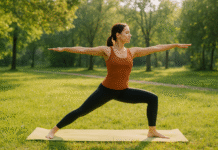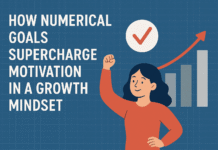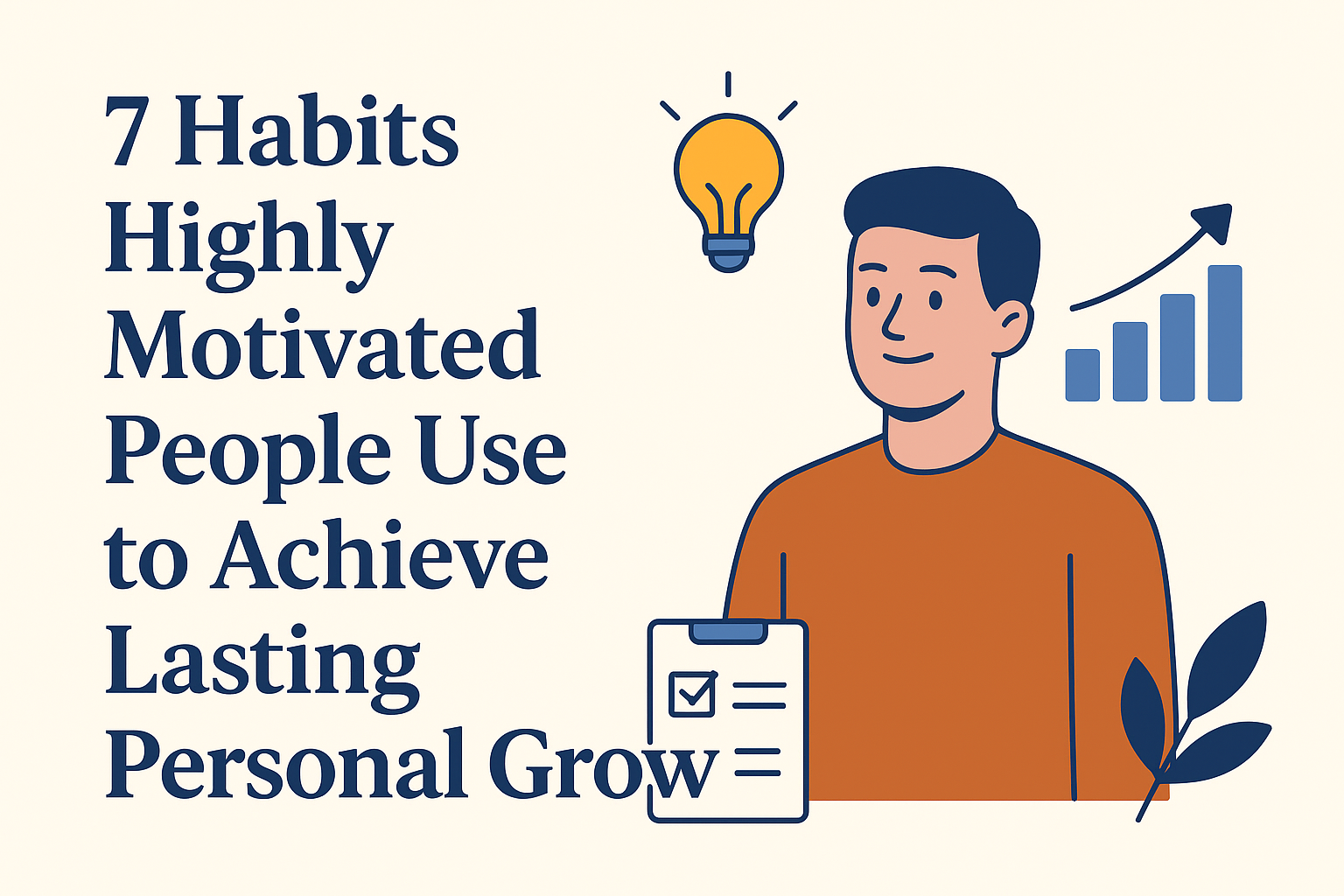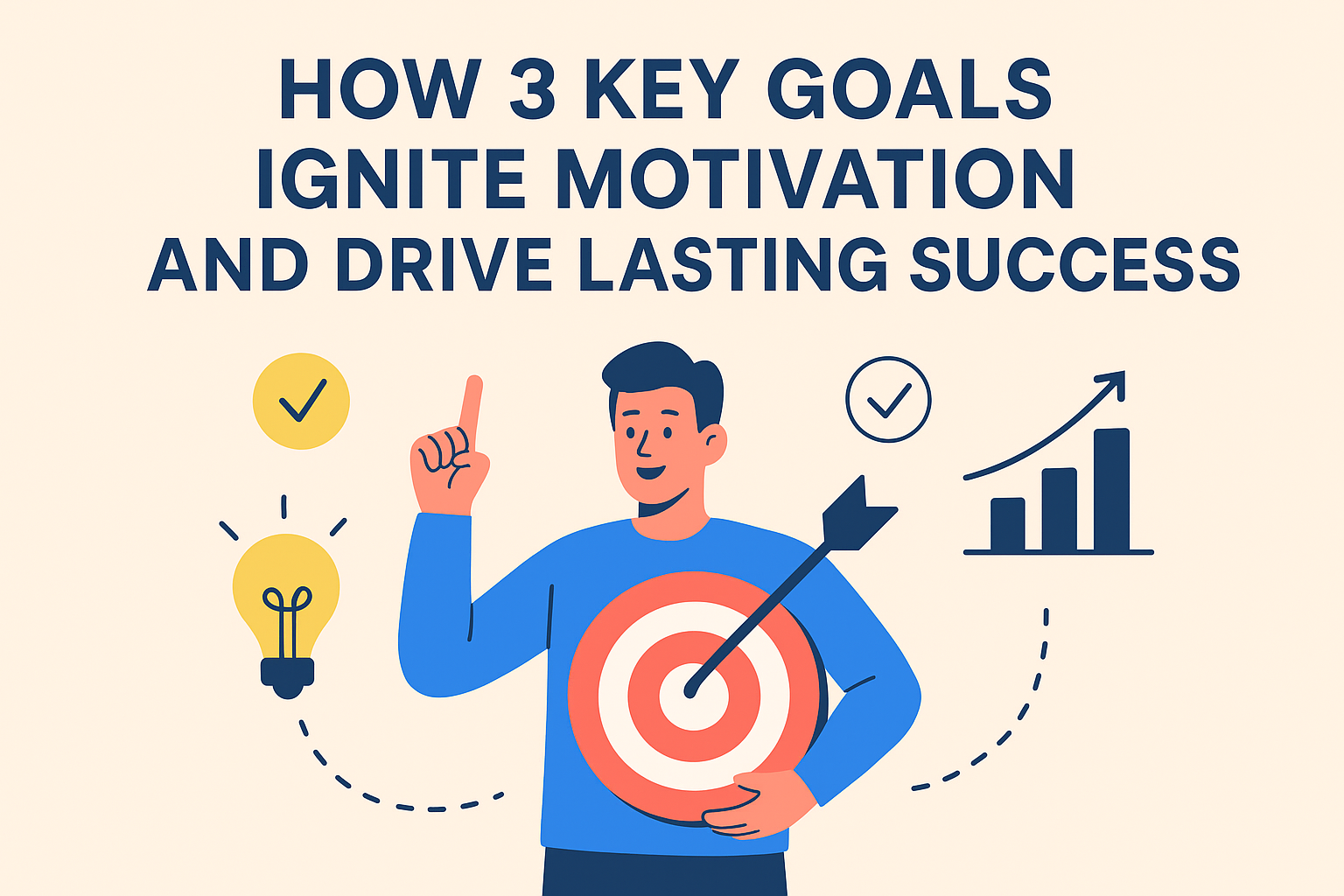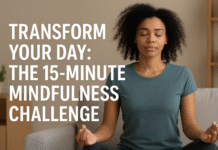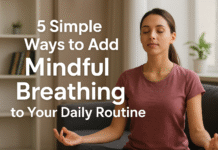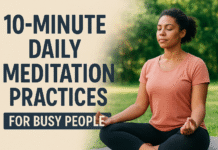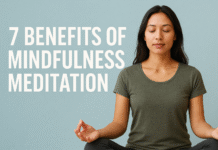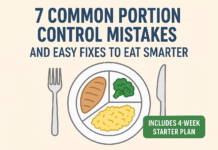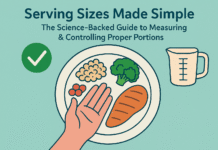Struggling to fall asleep quickly? A short, intentional nightly ritual — a 30-minute wind down routine — can shift your body and mind into “sleep mode” so you fall asleep faster and sleep more soundly. In the next pages you’ll learn exactly what a 30-minute routine looks like, why it works (in plain language), evidence-backed techniques you can pick and mix, troubleshooting tips, a 4-week starter plan, and 10 realistic mini-plans you can use tonight.
Medical & safety disclaimer: this article contains general sleep, relaxation, and lifestyle information. It is not a substitute for personalized medical advice. If you have chronic insomnia, suspected sleep disorders, heart or lung conditions, or take medications that affect breathing or sleep, consult a qualified healthcare professional before trying new techniques or major routine changes.
Key takeaways
- A consistent 30-minute wind down primes both body and brain for sleep by reducing arousal, stabilizing temperature cues, and reducing light-induced melatonin suppression.
- Small, repeatable actions beat occasional big gestures. Doing the same calming 30-minute sequence nightly creates a reliable conditioned cue for sleep.
- Simple tools work: paced breathing, progressive muscle relaxation, gentle stretching, dim lighting, and (optionally) a warm shower or bath timed 60–90 minutes before bed can reduce time to fall asleep.
- Track progress with simple metrics (minutes to fall asleep, time in bed vs time asleep, and sleep consistency) and expect measurable improvement within 1–4 weeks when you’re consistent.
What a 30-Minute Wind Down Routine Is (and why 30 minutes)
What it is and core benefits or purpose
A 30-minute wind down routine is a short, fixed sequence of calming activities you perform each night starting roughly 30 minutes before your intended lights-out time. Its purpose is to switch off the mental and physical processes that keep you awake—lowering physiological arousal, reducing cognitive rumination, signalling circadian systems that sleep is near, and making falling asleep faster and more predictable. Benefits include shorter sleep-onset latency (time to fall asleep), improved sleep efficiency (percentage of time in bed actually spent sleeping), and greater perceived sleep quality.
Requirements / prerequisites (equipment, cost, low-cost alternatives)
- Time: 30 minutes nightly. (If you’re short on time, 15 minutes still helps.)
- Space: a quiet, comfortable place to sit or lie down (your bedroom is ideal).
- Minimal equipment: soft lighting (lamp or dimmer), comfortable clothing, a notebook and pen (for journaling), and optionally a yoga mat or towel for stretches.
- Optional extras (low cost): inexpensive sleep mask, earplugs, a small Bluetooth speaker for guided audio, or a bedside lamp with warm (low-blue) bulbs.
- Low-cost alternatives: use phone with “do not disturb” and blue-light filter (or a simple kitchen timer) instead of dedicated devices.
Clear step-by-step instructions (beginner-friendly)
- Set a fixed start time: choose 30 minutes before you want lights off and put it on your schedule.
- Dim lights and reduce screen use immediately. (Use night mode or turn off screens entirely.)
- Do one calming breathing or relaxation practice for 5–10 minutes.
- Write 2–3 quick notes if your mind is busy (a three-line “shutdown” journaling).
- Gentle movement or stretching for 5 minutes if your body feels tense.
- Optional warm shower/bath 60–90 minutes before bed (if part of your routine).
- Lights out, bed cues only — get into bed only when sleepy.
Beginner modifications and progressions (scale up or simplify)
- Simplify: Start with just two steps: (A) dim lights and (B) 5 minutes of paced breathing. Do that consistently for two weeks.
- Progression: After 2 weeks, add progressive muscle relaxation, or extend breathing to 10 minutes, or make journaling a daily habit.
- Intensify for stuck nights: If you still can’t fall asleep, swap in a guided body-scan audio or a 10-minute slow-paced breathing session.
Recommended frequency / duration / metrics
- Frequency: nightly is ideal. If nightly isn’t realistic, aim for at least 5 nights/week.
- Duration: 30 minutes is the target; 15–60 minutes range is acceptable depending on personal preference.
- Metrics to track: sleep onset latency (minutes to fall asleep), total time in bed vs total sleep time, sleep consistency (bedtime/wake time variability). Track these daily for 4 weeks.
Safety, caveats, and common mistakes to avoid
- Avoid over-sleepy-enhancers: alcohol may make you fall asleep faster but fragments sleep later—don’t use it as a wind-down tool.
- Don’t use bright or blue-light screens during the wind down — they can suppress melatonin and delay sleep.
- If you have breathing or cardiac conditions, consult a clinician before doing breath-holding practices.
- Common mistakes: inconsistent routine timing, doing stimulating activities (work/email) during wind-down, or staying in bed awake for long periods (which weakens the bed→sleep association).
Sample mini-plan (2–3 steps)
- Mini-plan A (simple): Dim lights → 7 minutes paced breathing → lights out.
- Mini-plan B (for busy minds): 2-minute brain-dump on paper → 10 minutes progressive muscle relaxation → warm socks and bed.
The science: why a 30-minute routine helps you fall asleep faster
What it is and core benefits or purpose
A night routine works because sleep is regulated by interacting systems: a homeostatic “sleep pressure” that builds during waking, a circadian clock that times when you get sleepy, and momentary arousal (stress, thoughts, light) that can block sleep onset. The wind-down routine addresses the arousal piece and the timing cues so the other two systems can do their jobs. Benefits include measurable reductions in time to fall asleep and improvements in sleep quality when the routine is consistent.
Requirements / prerequisites
- Regular scheduling (go to bed within ~30 minutes of the same time nightly).
- Low-light environment in the last hour before bed.
- A routine that lowers sympathetic arousal (heart rate, adrenaline) — breathing, PMR, and gentle movement are practical tools.
Clear step-by-step explanation of the mechanisms
- Conditioning / learned cueing: repeating the same calm actions trains the brain to associate those actions with sleep onset, shortening the cognitive time to fall asleep.
- Melatonin timing: dimming light and avoiding short-wavelength (blue) light prevent melatonin suppression in the hour before bed, supporting timely sleep onset.
- Temperature cueing: a warm shower 60–90 minutes before bed can speed heat redistribution from core to skin, lowering core body temperature and signaling sleep readiness.
- Autonomic downshift: slow, paced breathing and progressive muscle relaxation increase parasympathetic (rest-and-digest) activity and heart-rate variability, lowering arousal.
Beginner modifications and progressions
- If you’re a night-owl: keep routine time fixed relative to your chosen bedtime rather than trying to force an abrupt earlier clock change. Gradually shift the start time earlier by 15 minutes every 3–4 nights.
- If you travel: pick a 30-minute anchor (e.g., breathing + reading a paperback) and maintain it in the new timezone to help entrain the clock.
Recommended frequency/duration/metrics
- Daily practice yields the fastest conditioning effect; short gains can appear in as few as a few nights but consistent improvement is likely over 2–4 weeks.
Safety, caveats, common mistakes
- Overreliance on stimulus substitution: Avoid replacing screens with equally stimulating activities (e.g., browsing social media in “dark mode” still engages the brain).
- Watch for paradoxical effects: If an activity causes anxiety (e.g., journaling that rehashes worries), change or shorten it. Use a “shutdown list” instead: a 2-minute note of tasks to handle tomorrow.
Mini-plan (2–3 steps) that uses the science
- Mini-plan (science-based): 30 minutes before bed: dim lights → 10 minutes slow breathing (6 breaths/min) → 5 minutes gentle stretching → lights out when sleepy.
The 30-Minute Wind-Down Blueprint — minute-by-minute plans you can copy
What it is and core benefits or purpose
This section gives plug-and-play 30-minute blueprints you can adopt or adapt. Each blueprint is designed to lower arousal, prime circadian cues, and reduce screen-related melatonin suppression.
Requirements / prerequisites
- Choose one blueprint and use it for at least two weeks before judging results.
- Set a consistent start time and stick to it within a 15-minute window nightly.
- Have a physical notebook or app ready for quick journaling or sleep tracking.
Blueprints (select one and use nightly)
Blueprint A — Calm & Simple (great for beginners) — 30 minutes
- T-30: Dim lights, set phone to Do-Not-Disturb.
- T-25: 7 minutes paced breathing (inhale 4 — hold 7 — exhale 8, or comfortable variant).
- T-18: 5 minutes gentle neck/shoulder stretches.
- T-13: 3 minutes brain-dump — jot 3 tomorrow tasks.
- T-10: Put on socks, brush teeth, get into bed.
- Lights out when sleepy.
Blueprint B — For the restless mind — 30 minutes
- T-30: Turn off bright lights, start soft instrumental audio (5–10 min).
- T-25: 10 minutes body-scan / progressive muscle relaxation.
- T-15: 5 minutes journaling: “Done / Tomorrow / Gratitude” (1–3 lines each).
- T-10: Sip warm decaffeinated drink (if it sits well).
- T-5: Put away device and lie down; lights out when sleepy.
Blueprint C — Physical release + thermal cue — 30–90 minute combo
- 90–75 min before bed: 10–15 min warm shower (or bath) then towel off.
- T-60: Light snack if hungry (small, protein + carb).
- T-30: 10 minutes gentle yoga for sleep.
- T-20: 5 minutes breathing, 5 minutes quiet reading in low light.
- Lights out when sleepy.
Beginner modifications and progressions
- Shorten: pick steps A and B only for a 15-minute routine.
- Progress: lengthen breathing or PMR to 15 minutes if you notice improvements. Gradually refine what works.
Recommended frequency/duration/metrics
- Use nightly for fastest conditioning. Expect to see improvements in time-to-sleep within a week and stronger effects in 2–4 weeks. Log sleep onset each night.
Safety, caveats, common mistakes
- Avoid eating heavy meals right before bed; they can delay fall asleep even if you’re relaxed.
- If a technique causes lightheadedness (breathing fast or holding breath too long), stop and resume gentler breathing.
Sample mini-plan (2–3 steps)
- Mini-plan (quick): Set phone to DND → 10 minutes slow, paced breathing → lights out.
Core techniques you can put inside your 30-minute routine (pick 2–3)
For each technique below: what it is, equipment, step instructions, beginner modifications, recommended frequency/duration, safety/caveats, and a small example mini-plan.
Technique 1 — Slow, paced breathing (including 4-7-8 style)
What it is and core benefits: controlled breathing shifts autonomic balance toward parasympathetic activation, lowers heart rate, and eases cognitive arousal. Evidence shows paced breathing before bed can shorten sleep onset time and improve sleep efficiency. Taipei Medical University
Requirements / prerequisites: comfortable chair or bed; no equipment required. Optionally use a breathing app or guided audio.
Step-by-step
- Sit or lie comfortably.
- Inhale gently through the nose for 4 counts.
- Hold for 7 counts (or comfortable shorter hold).
- Exhale slowly through the mouth for 8 counts.
- Repeat 6–8 cycles, then breathe normally and notice calm.
Beginner modifications and progressions
- If 7-count hold is hard: use 3-4-6 or 4-4-6 counts.
- Progression: extend the exhale length gradually to 10 seconds as you get comfortable.
Recommended frequency/duration/metrics
- Duration: 5–12 minutes nightly inside the wind down.
- Metric: perceived relaxation, heart-rate calmness.
Safety, caveats
- Avoid prolonged breath holds if you have respiratory disease or uncontrolled high blood pressure. Consult a clinician first.
Mini-plan: 8 minutes slow breathing (4-7-8 × 6 repetitions) right after dimming lights.
Technique 2 — Progressive Muscle Relaxation (PMR)
What it is and core benefits: PMR sequentially tenses and relaxes muscle groups to identify and release bodily tension. RCTs and clinical studies show PMR improves sleep quality and reduces anxiety. PubMed
Requirements / prerequisites: quiet place and comfortable surface.
Step-by-step
- Lie down comfortably.
- Starting at your feet, tense the muscles for 4–6 seconds, then release for 10–20 seconds.
- Move up the body (calves → thighs → abdomen → hands → arms → shoulders → neck → face).
- Breathe slowly throughout.
Modifications / progressions
- Short PMR: choose 3-4 regions (feet, legs, shoulders, face) for 6–8 minutes.
- Progress: full 10–15 minute PMR when ready.
Recommended frequency/duration/metrics
- Use 3–7 nights weekly. Track subjective sleep quality and calmness.
Safety, caveats
- If tensing causes pain (e.g., injury), skip that muscle and focus on the release phase only.
Mini-plan: 10 minutes PMR focusing on lower body tension release.
Technique 3 — Light yoga / stretching for sleep
What it is and core benefits: gentle postures and forward folds relax the nervous system, release physical tension, and reduce restless sensations. Short evening yoga sessions can help accelerate sleep onset. Nature
Requirements / prerequisites: small mat or towel; comfortable clothing.
Step-by-step
- 5 minutes of slow movements: Cat-Cow, seated forward fold, gentle supine twist, legs up the wall.
Modifications / progressions
- Chair variations available for limited mobility.
- Progress: extend to a 15-minute bedtime yoga flow.
Safety
- Avoid vigorous or heating sequences right before bed.
Mini-plan: 6 minutes gentle poses followed by slow breathing.
Technique 4 — Brief journaling / “shutdown list”
What it is and core benefits: a rapid, structured writing exercise to capture tomorrow’s tasks and offload worry. Helps reduce pre-sleep cognitive arousal.
Requirements / prerequisites: pen and small notebook.
Step-by-step
- 2–5 minutes: write three things you did well today, three tasks for tomorrow, and one short gratitude line.
Modifications / progressions
- Use a phone app if preferred, but avoid bright screens.
Safety/caveats
- Avoid long, detailed rumination journals at bedtime; the goal is quick offloading.
Mini-plan: 3-minute shutdown list (Done/Tomorrow/Gratitude).
Technique 5 — Light reading (paper book) / audio
What it is and benefits: calming fiction or neutral non-fiction read in dim light helps distract from stress and ease cognitive arousal. Use paper books or audiobook played through a speaker rather than phone screen.
Requirements: a paperback or bedside speaker.
Mini-plan: 10 minutes of light reading aloud in a calm voice or audiobook.
Practical add-ons: quick-start checklist, troubleshooting, tracking, and a 4-week starter plan
Quick-start checklist / warm-up (printable)
- Pick a consistent bedtime and set wind-down start time.
- Put phone on Do-Not-Disturb; turn on warm/dim lights.
- Prepare a pen and notebook.
- Choose 2–3 calming techniques from this article.
- Set a timer for 30 minutes.
- If using a shower/bath, do it 60–90 minutes before bed.
Troubleshooting / common pitfalls
- Problem: You’re doing the routine but still lying awake for 60+ minutes.
Fix: Get out of bed after 20 minutes of being awake and do a quiet activity (low light); return when sleepy. This preserves the bed→sleep association. - Problem: Your mind runs at night.
Fix: Use the 3-line “shutdown” journaling method. Schedule worry time earlier in the evening. PMC - Problem: You feel too rushed.
Fix: Shorten the routine to 15 minutes and be consistent; intensity matters less than repetition. - Problem: Partner or children disrupt routine.
Fix: Negotiate a shared minimal routine (lights dim, 10 minutes breathing), or use earplugs/eye mask for personal space.
How to measure progress or results (simple metrics)
- Sleep onset latency (SOL): minutes from lights out to first sleep. Track nightly.
- Sleep efficiency: ratio of time asleep to time in bed. Useful if you have a tracker.
- Consistency: standard deviation of bedtime across 7 days. Aim to reduce variability.
Record these in a simple nightly log. Evaluate at the end of each week.
A simple 4-week starter plan (roadmap)
Week 1 — Habit formation
- Pick one blueprint (e.g., Blueprint A). Do it 5–7 nights. Track SOL each night.
Week 2 — Stabilize
- Keep same blueprint. Add journaling if mind racing. Aim for 6 nights. Record sleep efficiency.
Week 3 — Tweak
- Swap or mix techniques (e.g., replace breathing with PMR twice this week). Note what feels easiest.
Week 4 — Consolidate
- Continue the best version and evaluate: have you reduced SOL by 10–30 minutes? If yes, keep. If no, consider medical evaluation or CBT-I pathways.
Longer-term strategies, when to seek help, and real-world tips
What to watch for (red flags)
- Difficulty falling asleep for more than 30 minutes most nights for 3+ months, daytime impairment (fatigue, poor concentration), or strong symptoms of other sleep disorders (loud snoring with gasping, restless legs, or excessive daytime sleepiness). In these cases, seek evaluation from a qualified sleep clinician.
Real-world tips for adherence
- Pair the routine with a keystone habit (e.g., brushing your teeth).
- Use environmental cues: bedtime lamp, diffuser, or a particular playlist to make the routine automatic.
- Avoid “all-or-nothing” thinking: a short nightly routine is far better than none.
Complementary approaches
- If you have chronic insomnia, the most effective evidence-based treatment is a multi-component behavioral therapy program (CBT-I). Consider it if routine changes aren’t enough.
Frequently Asked Questions (10 concise answers)
- Does a 30-minute routine really make a difference?
Yes — consistent pre-sleep routines reduce arousal and can shorten sleep onset time, especially when combined with low light and stimulus reduction. Many people notice improvements within 1–4 weeks. - Can I use screens during my wind down if I enable night mode?
Minimize screen time. Night modes reduce blue light but don’t eliminate cognitive stimulation. If you must use a device, enable full blue-light filters and keep content passive (e.g., audiobooks), not interactive. - What if I don’t have 30 minutes every night?
Do 15 minutes consistently — that still helps. Consistency outweighs length in the early weeks. - Is warm milk or herbal tea useful in a wind down?
A warm, low-caffeine drink can be part of the ritual for some people. Avoid caffeinated drinks in the afternoon/evening. NHLBI, NIH - How quickly will I see results?
Many people see small gains in nights 1–7; stronger, more sustained gains often emerge across 2–4 weeks of nightly practice. aquila.usm.edu - Is the 4-7-8 breathing the only breathing I should try?
No — it’s a useful template. Any slow, paced breathing (resonance frequency around 6 breaths/min) that lowers arousal can work. Modify counts to comfort. - If I take a bath, how long before bed should it be?
Aim for about 60–90 minutes before lights-out. The post-bath drop in core temperature is part of the benefit. - Can I combine this with sleep medication?
Talk with your prescribing clinician. Behavioral routines complement medication, and many clinicians prefer combining approaches rather than relying on pills alone. - What if I’m often woken by a partner or child?
Build in flexibility: do the first part of your routine earlier while the house is quieter, and use earplugs or a sleep mask as needed. Consider negotiation and schedule alignment with household members. - What if my sleep problem is severe?
If insomnia is chronic (months), severe, or accompanied by daytime impairment, seek assessment for evidence-based treatments like CBT-I or a sleep clinic evaluation.
Final thoughts (motivating close)
A 30-minute wind down routine is a small, low-cost habit with high leverage. It gives your nervous system a predictable cue that sleep is coming, reduces the small daily stresses that hold us awake, and creates the conditions that let your biological sleep systems do their work. Start simple, stay consistent, track a couple of metrics, and tweak based on what helps you feel calmer and sleep sooner. Small nightly investments add up to reliably better rest.
Ready to try it tonight? Pick one mini-plan from this article and commit for one week.
References
- How to Build a Better Bedtime Routine for Adults. Sleep Foundation. (2025). . Sleep Foundation
- The inner clock—Blue light sets the human rhythm. Author(s). (2019). National Library of Medicine (PMC). https://www.ncbi.nlm.nih.gov/pmc/articles/PMC7065627/. PMC
- Before-bedtime passive body heating by warm shower or bath to improve sleep: a systematic review and meta-analysis. Shahab Haghayegh et al., Sleep Medicine Reviews, 2019. . PubMed
- Epidemiology of Insomnia: Prevalence, Course, Risk Factors, and Public Health Implications. (2022). PubMed. . PubMed
- Trouble sleeping? Data on adults who had trouble falling asleep (2020 brief). Centers for Disease Control & Prevention. (2023). . CDC
- Cognitive Behavioral Therapy for Chronic Insomnia — systematic review / meta-analysis. PubMed. (2015). . PubMed
- Progressive muscle relaxation alleviates anxiety and improves sleep: randomized controlled study (PMC). 2024. https://www.ncbi.nlm.nih.gov/pmc/articles/PMC11091277/. PMC
- Influence of a 30-Day Slow-Paced Breathing Intervention Compared … Journal (MDPI). (2019). . MDPI
- The role of sleep hygiene in promoting public health: A review of empirical evidence. (2015). PubMed Central. https://www.ncbi.nlm.nih.gov/pmc/articles/PMC4400203/. PMC
- Sleep latency — what it means and why it matters. (2025 update). Sleep Foundation. . Sleep Foundation
- Effects of bathing-induced changes in body temperature on sleep. (2023). PubMed Central. https://www.ncbi.nlm.nih.gov/pmc/articles/PMC10486043/. PMC


